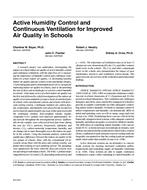Description
A research project was undertaken, investigating the impact on school indoor air quality of active humidity control and continuous ventilation, with the objectives of (1) measuring the importance of humidity control and continuous ventilation on school indoor air quality, (2) developing baseline indoor air quality data for schools in hot and humid climates, (3) providing data and recommendations for HVAC designs for improving indoor air quality in schools, and (4) documenting the role of desiccant technologies to actively control humidity in schools. A literature review of school indoor air quality was the first task followed by a field investigation of the indoor air quality in ten noncomplaint Georgia schools in matched pairs of schools with conventional systems and schools with desiccant-cooling systems. Continuous monitors for carbon dioxide, temperature, and humidity were placed in one location in each school for approximately one year. In the same room with the continuous monitor, time-weighted volatile organic compound (VOC) samples were taken for approximately 30- day periods throughout the investigational period. Additionally on-site samples were collected at least four times during the year for VOCs, particles, bioaerosols, aldehydes and ketones, CO2 , carbon monoxide, temperature, humidity, and air change rate to more thoroughly assess the indoor air quality in the schools. Using discriminant analysis, statistically significance differences between the indoor air quality in the two groups of schools, those with the conventional HVAC systems versus those with the desiccant cooling systems, was found when looking at each sampling period. The groupings were adjusted for the times when the desiccant systems were not operating in individual schools. The Wilks’ Lambda values ranged between 0.163 and 0.276, depending on the period, and r < 0.001. The importance of ventilation rates of at least 15 cfm/person were demonstrated by the CO2 and other contaminant levels in the schools. The CO2 and other contaminant levels in the schools also demonstrated the impact of poor maintenance practices and ventilation system design. This paper presents an overview of the ventilation and temperature findings.
Authors: Charlene W. Bayer, Ph.D., Robert J. Hendry, John C. Fischer, Sidney A. Crow, Ph.D.
Citation: Indoor Air Quality 2001 Moisture, Microbes, and Heath Effects: Indoor Air Quality and Moisture in Buildings Conference Papers
Keywords: November, California, 2001, IAQ
Citation: IAQ Conference: IAQ 2001
Product Details
- Published:
- 2001
- File Size:
- 1 file , 790 KB
- Product Code(s):
- D-8167




